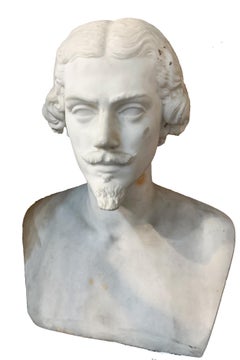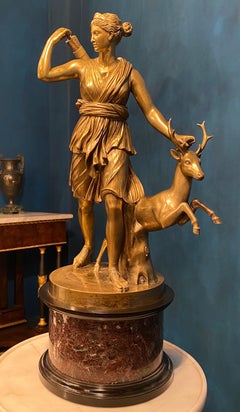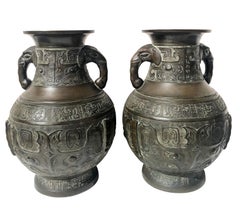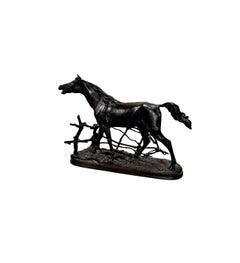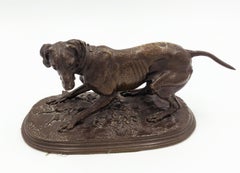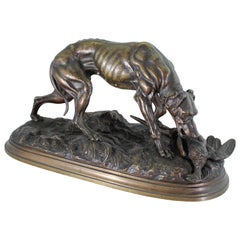Mid-19th Century Figurative Sculptures
to
7
33
15
14
3
9
Overall Width
to
Overall Height
to
172
570
2,181
7,470
70
43
105
113
60
123
203
174
217
269
58
1
46
39
39
32
25
17
14
10
9
7
6
5
3
3
3
2
2
2
2
2
52
51
18
17
5
7
7
4
2
1
39
35
Period: Mid-19th Century
Italian Mid 19th century White Carrara Marble bust. Portrait of young male.
Located in Firenze, IT
Italian Portrait White Marble Bust in a Heroic Attitude.
Carrara statuary Marble.
Tuscan school.
Circa 1850.
Bust depicting a young man with bare shoulders.
This model draws inspira...
Category
Academic Mid-19th Century Figurative Sculptures
Materials
Marble
$3,603 Sale Price
20% Off
Grand Tour Bronze Sculpture of Diana Goddess of the Hunt Signed B. Boschetti.
Located in Rome, IT
Grand Tour Fine Group of Sculpture in Bronze after a Louvre Diana of Versailles or Artemis, Goddess of the Hunt.
Diana is represented at the hunt, hastening forward, as if in pursui...
Category
Academic Mid-19th Century Figurative Sculptures
Materials
Bronze
Pair of 19th Century Japanese Bronze Vases
Located in Lake Worth Beach, FL
Pair of large late 19th Century Japanese bronze vases with elephant heads handles, and details in dark brown and green patina as shown on the photos.
Category
Mid-19th Century Figurative Sculptures
Materials
Bronze
P.J. Mene 1846, Bronze cast+ Djinn, Arabian Stallion
Located in Gent, VOV
Djinn, Arabian stallion 1846
A French bronze horse with a dark patina with brown undertones entitled 'Djinn étalon arabe' cast from the model by Pierre-Jules Mène (1810-1879), secon...
Category
French School Mid-19th Century Figurative Sculptures
Materials
Bronze
Chien Braque (Tom)
Located in Missouri, MO
Pierre Jules Mene
"Chien Braque" (Tom)
Bronze
approx. 5 x 9 x 4.25
Signed
PIERRE JULES MENE (1810-1879)
Pierre Jules Mene, (P. J. Mene), was born in Pa...
Category
Realist Mid-19th Century Figurative Sculptures
Materials
Bronze
Jules Moigniez Bronze Sculpture of a Pointer and Pheasant, 19th Century
Located in Dallas, TX
Image of Jules Moigniez Bronze Sculpture of a Pointer and Pheasant, 19th Century
Jules Moigniez Bronze Sculpture of a Pointer and Pheasant, circ...
Category
Mid-19th Century Figurative Sculptures
Materials
Bronze
Inkwell
Located in PARIS, FR
Inkwell
"Boar Hunting"
by Christophe FRATIN (1801-1864)
Cast in bronze with nuanced brown patina
Signed on the hinge of the lid "Fratin"
A very rare old cast
France
circa 1845
heig...
Category
French School Mid-19th Century Figurative Sculptures
Materials
Bronze
Bear Dentist
Located in PARIS, FR
Bear Dentist
by Christophe FRATIN (1801-1864)
Bronze with nuanced old gilt-light brown patina
Signed on the base "Fratin"
Old edition cast
France
mid-19th century
height 15 cm
A s...
Category
French School Mid-19th Century Figurative Sculptures
Materials
Bronze
19th Century Austrian Sculpture of Fate
By Franz Melnitzky
Located in Los Angeles, CA
A signed, dated, 1855 terracotta, classical style sculpture of the robed figure of Fate holding the thread of life by listed, Austrian-born artist, Franz Melnitzky (1822-1876) whose ...
Category
Mid-19th Century Figurative Sculptures
Materials
Terracotta
Monkey Match Holder
Located in PARIS, FR
Monkey Match Holder
by Christophe FRATIN (1801-1864)
Bronze with nuanced brown patina
Signed on the base "Fratin"
Old edition cast
France
circa 1850
height 14,5 cm
width 10 cm
dep...
Category
French School Mid-19th Century Figurative Sculptures
Materials
Bronze
Superb Neoclassical White Marble Bust of Flora France 1850 '
Located in Rome, IT
Superbly carved white statuary Carrara marble bust of Flora, the goddess of flowers.
Flora was often associated with the coming of spring and th...
Category
Mid-19th Century Figurative Sculptures
Materials
Marble
Sculpture of a Young Boy with Robe
Located in Milford, NH
A fine classical form marble sculpture of a young boy with robe by Irish / American artist Martin Milmore (1844-1883). Milmore was born in Sligo, Ireland and was brought to Boston, Massachusetts in 1851, where his training began with his brother, Joseph, a stonecutter, who later became his assistant. Milmore was apprenticed to Thomas Ball from 1858 to 1862 working mainly on his equestrian "George Washington" (1858-61, Boston Public Gardens). After Ball departed for Italy, Milmore became Boston's leading sculptor. Realistic in his style, he is best known for his Civil War monuments and sculptures of prominent Bostonians including Wendell Phillips...
Category
Mid-19th Century Figurative Sculptures
Materials
Marble
Self-portrait
Located in PARIS, FR
Self-portrait
"Fratin by himself"
by Christophe FRATIN (1801-1864)
Bronze with nuanced dark brown patina
Signed on the base "Fratin"
Raised on a wooden base, with an old collector s...
Category
French School Mid-19th Century Figurative Sculptures
Materials
Bronze
Bronze Figural Torchères and Pedestal - Médaille d'or - Exposition de 1867
Located in New York, NY
A. LACARRIÈRE PÈRE, FILS & CIE
French, (Mid 19th century)
Bronze Figural Torchères - Médaille d'or - Exposition de 1867
Monumental Patinated Bronze Figural Torchères on Pedestal; ...
Category
Mid-19th Century Figurative Sculptures
Materials
Marble, Bronze
